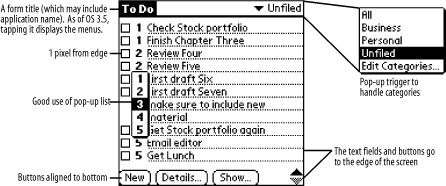The Well-Designed Form
Now that you have seen some examples of the UI objects available on the Palm OS, and seen how the audience of an application can affect its design, it is worthwhile to show you some well-designed and not-so-well-designed forms. We will also point out important placement rules that agree with Palm’s own guidelines along the way.
Here are the important optimization rules to use when designing your forms:
The quintessential handheld tasks your application provides should drive the design.
Minimize the number of taps and time to complete frequent actions (follow the 80/20 rule).
Minimize screen clutter by hiding infrequent actions in menus and other forms.
Provide command buttons for common multistep activities.
Minimize switching screens for common tasks.
Be clever in implementing unique aspects of the application.
In these next sections, we will show you some forms that in some ways follow these placement rules and in some ways that violate them. You should keep these optimization rules in mind as we look at their designs.
The To Do List—A Well-Designed Main Form
We are looking at the To Do list as an example of a well-designed main form of a built-in application (Figure 3-34).

Figure 3-34. The To Do list
Some of the essential features of any main form of an application are:
It uses the entire screen or in other words, it is modeless.
It has a title (tapping on the ...
Get Palm OS Programming, 2nd Edition now with the O’Reilly learning platform.
O’Reilly members experience books, live events, courses curated by job role, and more from O’Reilly and nearly 200 top publishers.

